Port Orford Cedar Lawson CypressChamaecyparis lawsonianaHeight: 50' average mature height Hardiness Zones: 5-8 Find my zone Aspect: full shade to full sun
Size Availability
In the Cupressaceae family and very closely related to the Cypress genus,
Chamaecyparis lawsoniana
covers a very small native range and is listed as near threatened in the wild. It is a wonderful conifer for most any landscape with many common names, including White Cedar, Lawson Cypress, Western White False Cypress, Port Orford Cedar (of which is named after the City of Port Orford, and was once one of the major timber species harvested). We much prefer the Port Orford Cedar as an alternative to hedge plants such as the Leyland Cypress as the Port Orford has far fewer problems. The roots are very strong and not as likely to rip out as others, the growth is far more even and the trunk wood is far stronger than many cypress alternatives. Additionally, the lacy scale-like foliage is a light silver grey - a much more attractive and interesting color for a hedge than most of the true cypress that tend to have a brownish tint.
1 gallon 20 to 26 inches tall - $19.99 each
Bulk Pricing: $17.50 each for 5 or more - 12% off Bulk Pricing: $15.00 each for 10 or more - 25% off
Ships free with orders of $75!Packed with a bagged root ball.
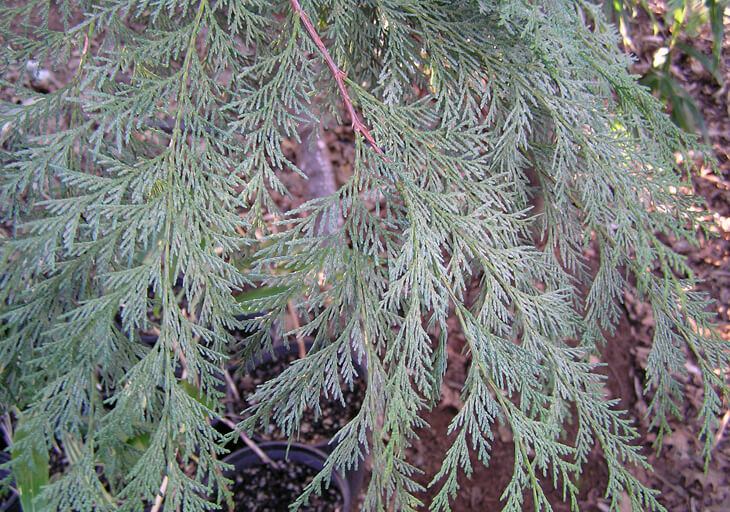
Notable Uses
In the landscape, this makes an excellent specimen plant or a fantastic privacy screen in a row. The top couple feet of the central leader will usually curve downwards, giving it the appearance of a mountain hemlock on a snowy peak. Foliage will continue growing to the base of the tree until cut to reveal slightly fibrous bark, which was often pulled away by Native Americans for weaving or medicinal uses. The light colored wood is strong and rot resistant, similar to most members of the Cypress family (including Eastern and Western Red Cedar, Giant Sequoia and Redwood). Harvested timber fetches a high price in Asia and is usually exported to Japan from Port Orford, Oregon. Because the wood is so fine grained and solid, it is often used in making instruments such as guitars. Native populations, which were tiny in range to begin with, have been greatly over harvested and combined with a root rot in the wild has prompted the species to be listed as near threatened.
Shade and Drought Tolerance
The Port Orford Cedar is very shade tolerant and will grow with less sun exposure than most any other conifer. The scale-like pattern of the foliage provides more surface area than regular needles or leaves, allowing photosynthesis to occur with less light available. Additionally, like most Western Natives, the Port Orford Cedar is very drought tolerant once established. At our nursery in Southern Oregon, summer temperatures will often range from 95-105 with very low humidity from June until September. Any soaking rain enough to get to the roots before evaporating away is uncommon from the end of May until October or November. In the wooded area above our nursery, we've established several Port Orford Cedar by watering them with a bucket twice their first year, and then letting them fend for themselves. Even though they are planted in a dry and hot site they have managed to grow several feet per year.
Information on the False Cedars (for those who care about botany)
Many American species within the Cypress family have "Cedar" included in their names (Incense Cedar, Port Orford Cedar, Red Cedar, White Cedar, etc.) because the wood of many Cypress species has the same aromatic smell as the true Cedars, which are native to the Mediterranean. Many of the false Cedars now have had changes made to their common names to reflect that they are not actually Cedars - for example, Incense Cedar is now officially named "Incense-cedar" to designate it is a false cedar.
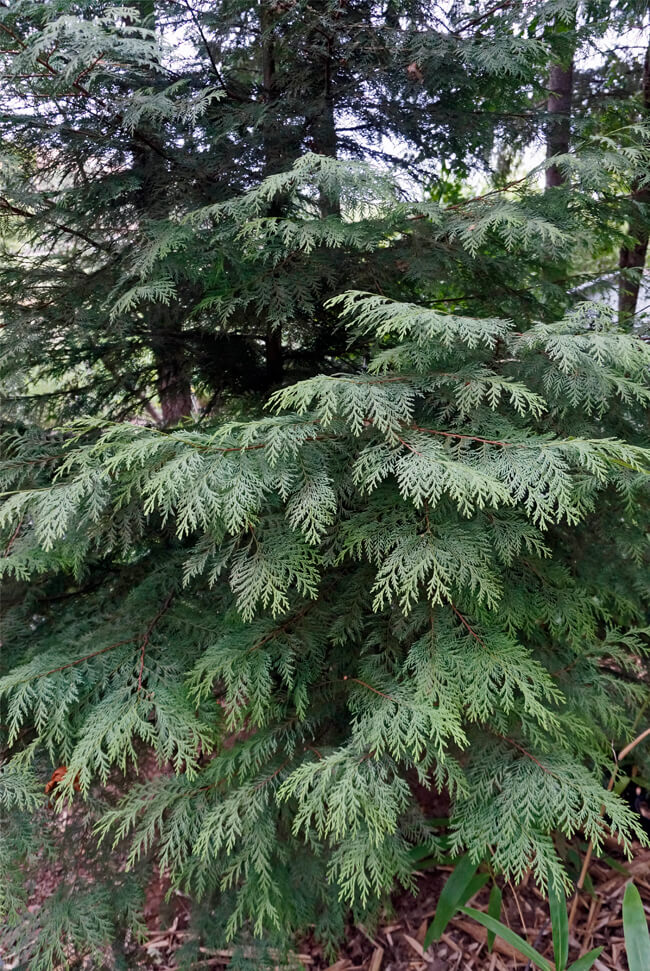
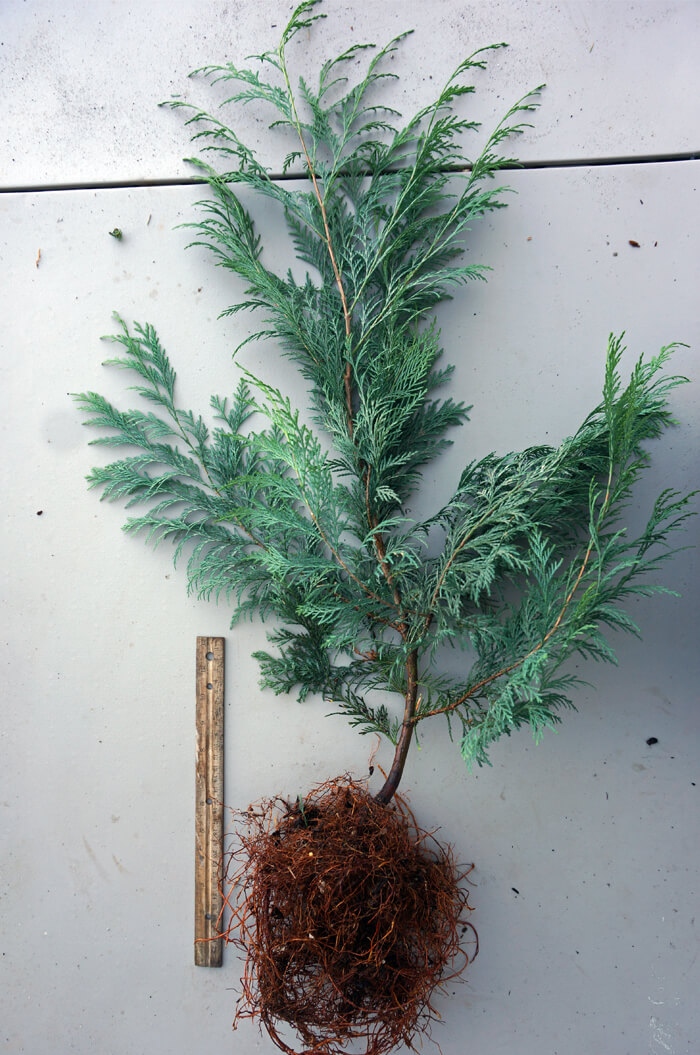
A two gallon Port Orford Cedar 
Chamaecyparis lawsoniana - Port Orford Cedar Lawson Cypress bark in southwest Oregon

Chamaecyparis lawsoniana - Port Orford Cedar Lawson Cypress old growth in southwest Oregon

Chamaecyparis lawsoniana has a narrow form with dense, well-defined edges when mature
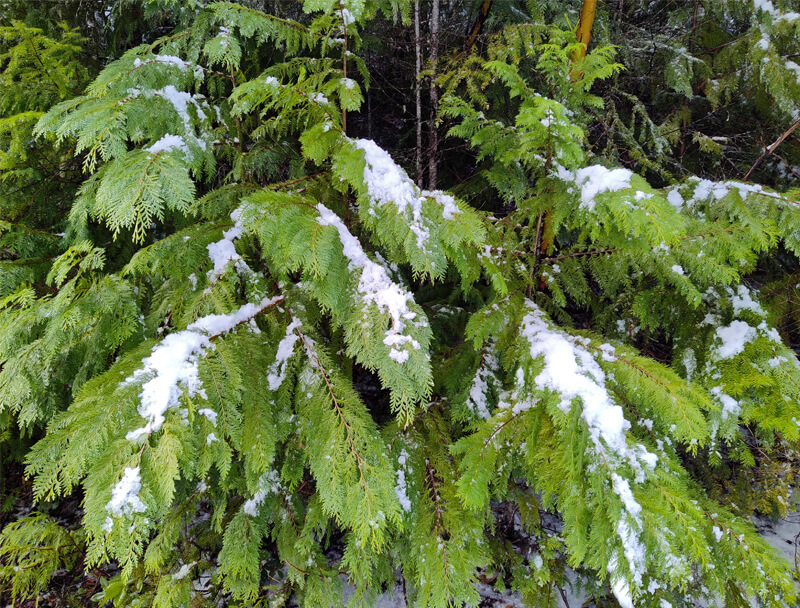
Chamaecyparis lawsoniana - Displaying the fern-like foliage of the side branches
Packing Plants For ShippingMost of our plants are shipped bare root while they are dormant from late November through April and ship via the U.S. Postal Service. Bamboo plants can be shipped in their containers year-round by UPS.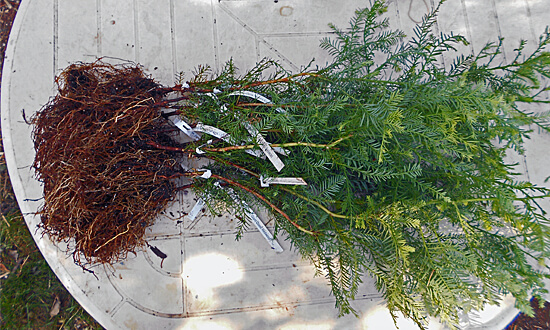 Bare root plants are soaked and wrapped together in bundles. ictured are 10x 24 inch tall Coast Redwoods. 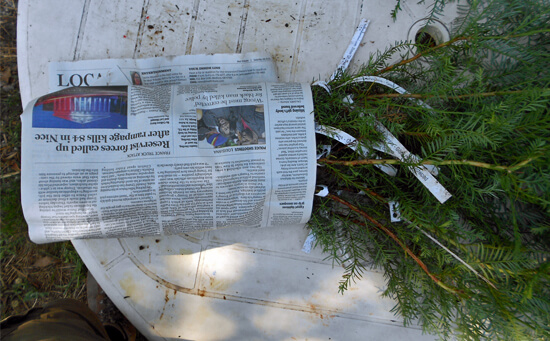 The bundled plants are wrapped in paper and labeled by variety. 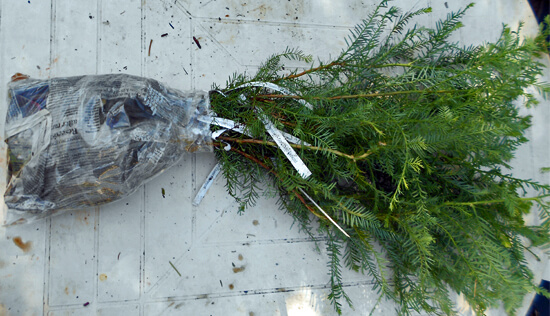 The bundle is wetted and bagged. 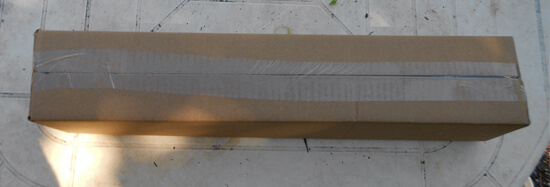 Bundles of plants are secured in long boxes. Pruning and Plant SizesWe prune both the tops and the roots of our plants at least once per year while they are growing in our nursery to ensure they develop a strong, dense form. Regular annual pruning goes a long way to ensure a healthy branching structure and this is often a missed step in many nurseries. Pruning a plant back hard after it has been neglected pruning-wise often results in an irregular branch habit or multiple leaders so we prune early and regularly instead. We also prune the roots of our plants while they are dormant which causes them to produce a much more branched structure and helps to elimate tangled masses that hinder future development. Plants that have been root pruned establish themselves much more quickly than root bound plants. Generally, hardwood plants will be pruned in the winter and conifers will be pruned in the summer.Before shipping plants we prune the tops and roots one last time. Conifers will usually have very little pruning except to balance out long branches. Shrubs are usually pruned to around 1-2 feet tall to encourage low branch development and small to medium sized trees are usually pruned to around 36-40 inches. Pruning trees at this height encourages dominant branches to begin forming around 3 feet from the ground which typically looks the best in most situations. However, if you want a tree to have branching start higher (some city codes require trees to not branch below 4 feet) we have longer boxes available. To request taller trees please contact us at least three days before your ship date. Depending on your location and the shipping routes there may be a fee for oversize package handling (usually about $15 for a 60 inch box). 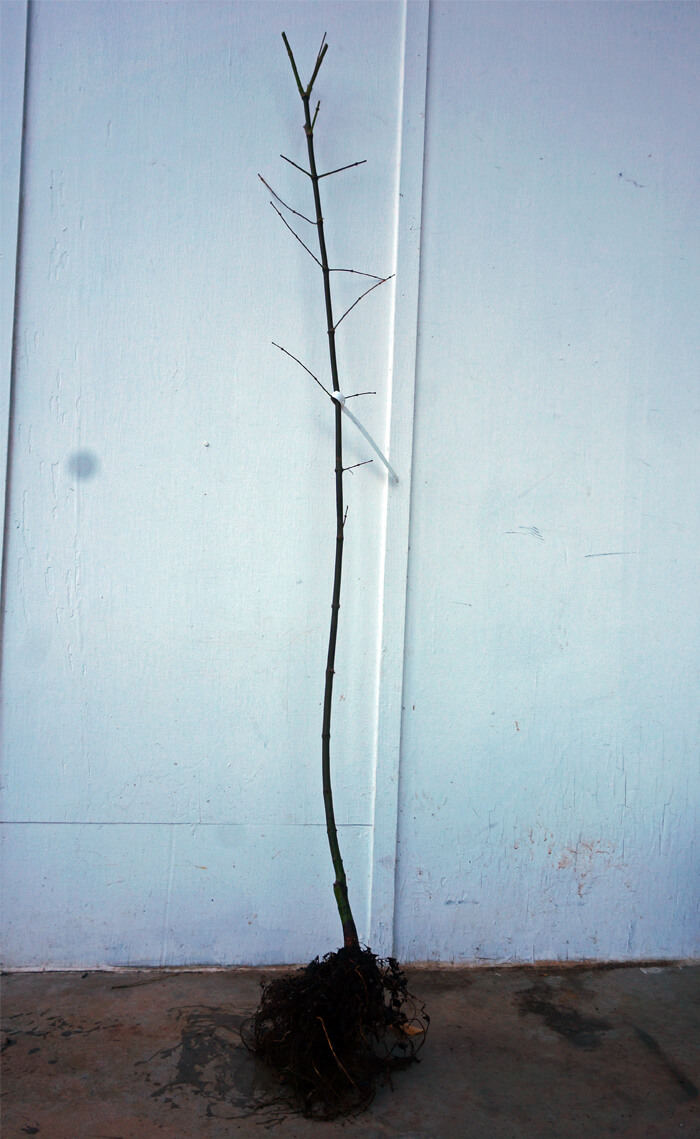 Tall trees (Oaks, Ginkgo, large Maples, etc.) are pruned to 40 inches to encourage crown development from about 36 inches and up 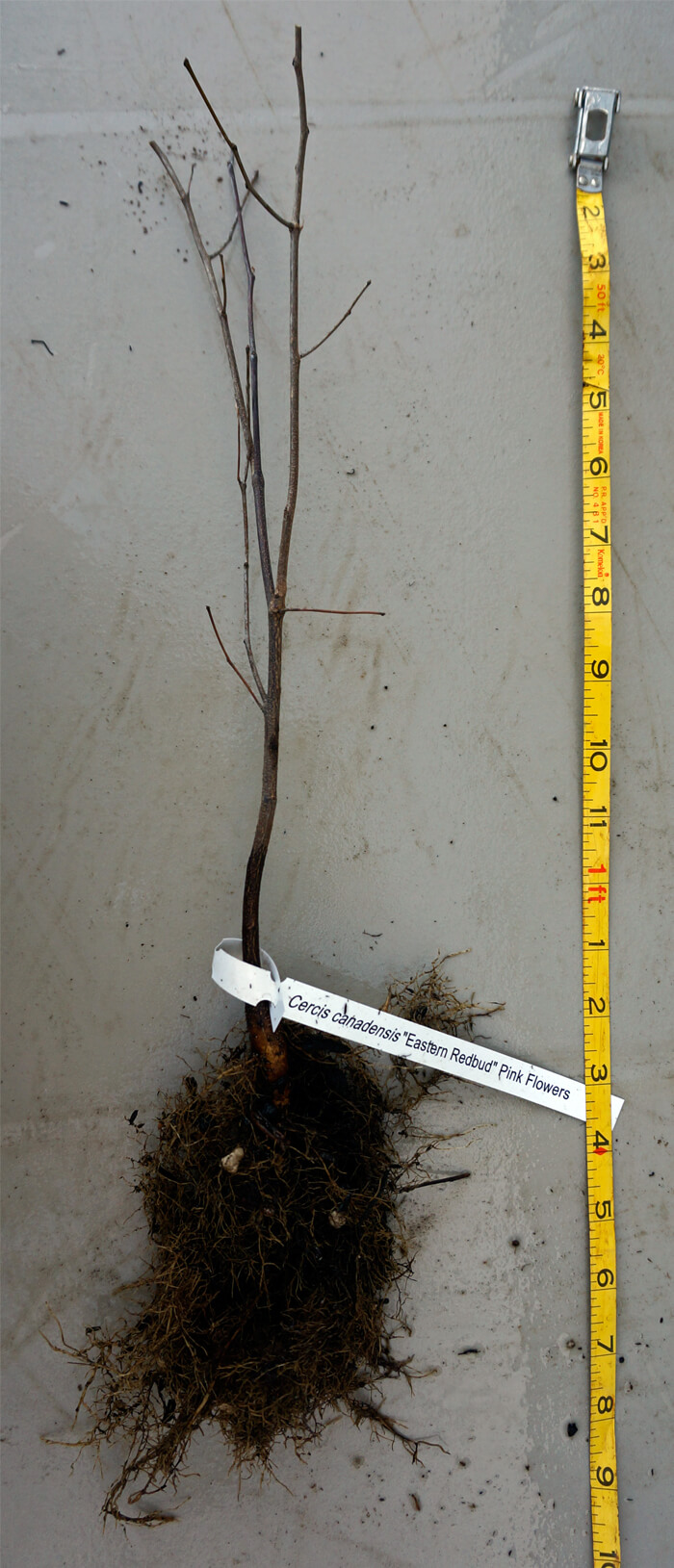 Small and medium trees (short Maples, Redbuds, Stewartia, etc.) are pruned 10-20 inches above the prune line from last year 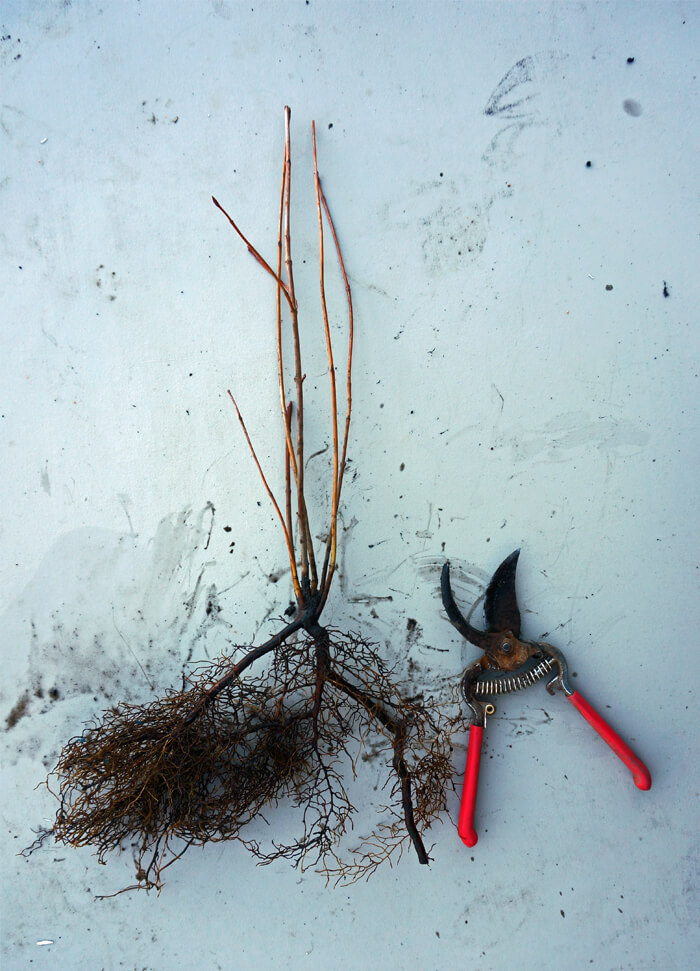 Shrubs (Weigela, Hydrangea, Viburnum, etc.) are pruned to 18 inches tall and root pruned one last time 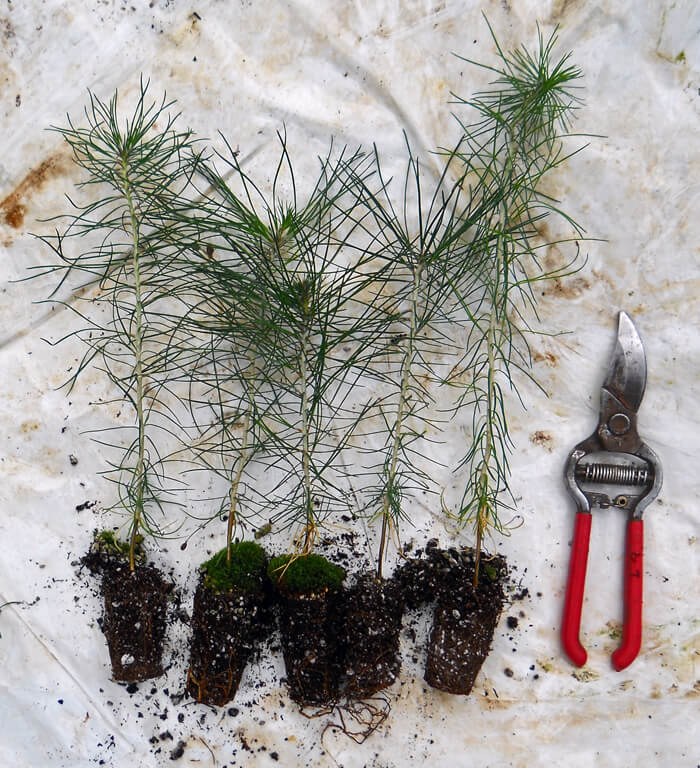 Small plug size Bamboo Plants Are Shipped In Their ContainersBamboo roots are not flexible and so plants have to be shipped in their containers. These plants are heavier and are shipped separately from bare root plants. Because they are potted they can handle longer transit times so can ship via UPS Ground instead of USPS Air Mail. Potted plants can also be shipped year-round.We regularly top our 1 gallon bamboo plants at 24-30 inches tall throughout the growing season. This results in dense, bushy foliage while allowing for economical shipping. From this size most running species will grow to 5-6 feet tall in the first spring and clumping species will usually grow to 4-5 feet tall. 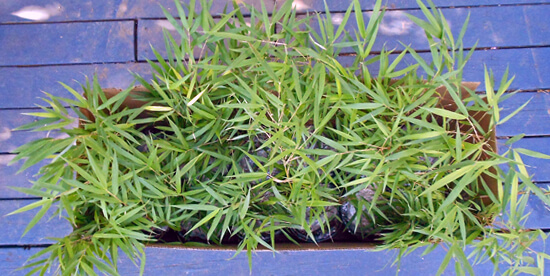 1 gallon bamboo plants strapped in and ready to be sealed. Unpacking Bare Root PlantsYou will be sent tracking details as soon as your plants are shipped. Unpack your plants as quickly as possible after they are delivered. We use two types of boxes, side-sealing and top-sealing. For boxes that are taped along the whole length you can cut the tape on either side and remove the plant bundles by cutting the tape holding the bundle to the bottom. For boxes that are sealed on the top and bottom, it is easiet to open the bottom of the box (the shipping label is at the top) and pull the bundle of plants out straight out. Check that the box is empty as there can be a second bundle of plants stuck towards the top.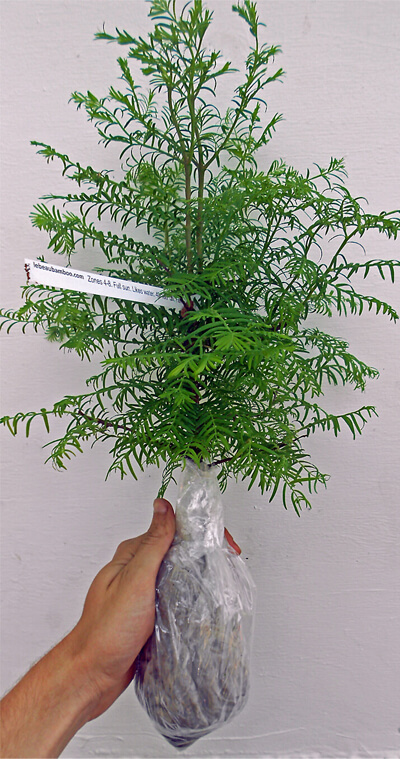 A bundle of trees. What if I am not able to plant right away?You can usually leave the plants in their shipping container unopened for 1-2 days if there were no shipping delays and you have received your plants from late November through February. Plants shipped when it is warmer can't stay in their packages for as long. |
Size Availability
1 gallon 20 to 26 inches tall - $19.99 each
Bulk Pricing: $17.50 each for 5 or more - 12% off Bulk Pricing: $15.00 each for 10 or more - 25% off
Ships free with orders of $75!Packed with a bagged root ball.
|

